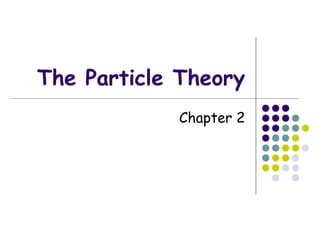
The Particle Theory Explained
- 1. The Particle Theory Chapter 2
- 2. The Particle Theory More than 2000 years ago, a Greek philosopher Democritus suggested that matter was made of tiny particles too small to be seen. He thought if you kept cutting a substance into smaller and smaller pieces, you would find the building blocks of matter.
- 3. 4 Principles of the Particle Theory 1. All matter is made of tiny particles. 2. All particles of one substance are the same. - Different substances are made of different particles. 3. The particles are always moving. - The more energy the particles have, the faster they move. 4. There are attractive forces between particles. - These forces are stronger when the particles are closer together.
- 4. Theparticle theory helps to explain two categories of substances that are encountered in chemistry.
- 5. Two Categories of Substances Category 1: Pure Substances - contains only one kind of particle - Types: elements and compounds Category 2: Mixtures - contains two or more different pure substances - Types: homogeneous and heterogeneous mixtures
- 6. Category 1: Pure Substances Type 1: Elements – pure substances that cannot be broken down into simpler substances - Examples: think Periodic table (oxygen, hydrogen) Type 2: Compounds – pure substances that contain two or more elements - Examples: Water (H2O), sugar (C6H12O6)
- 7. Category 2: Mixtures Type 1: Homogeneous (also known as solutions) – may be made up of solids, liquids or gases - this mixture is uniform (the same) throughout - Examples: air, alloys, kool aid, white vinegar, orange juice without the pulp Type 2: Heterogeneous – see each part easily, separated physically - this mixture is not uniform throughout - Examples: pizza, garbage, beach sand, vegetable soup
- 8. How to Classify Mixtures When two pure substances are mixed together, they may mix smoothly or unevenly. If the substances mix well with one another, the mixture is called a solution. If the particles don’t mix well together then we have a heterogeneous mixture.
- 9. Classify the Following Salt and water solution Pizza heterogeneous mixture Garbage heterogeneous mixture Air solution
- 10. Atoms and Molecules Atoms - each atom is made of one type of element - scientists now call the particles in the particle theory atoms - the periodic table of elements has 118 elements Molecules - contains two or more atoms joined together in combinations - Ex. C4H8 – contains 4 carbon atoms and 8 hydrogen atoms
- 11. Guess the Molecule I have 2 hydrogen atoms I have 1 oxygen atom I am water
- 12. Guess the Molecule I have 10 hydrogen atoms I have 2 oxygen atoms I have 7 carbon atoms I have 4 nitrogen atoms I am desired in the morning but avoid me in the evening Cola drinks have contain me I am what makes coffee special I am caffeine
- 13. Guess the Molecule I have 6 hydrogen atoms I have 6 oxygen atoms I have 6 carbon atoms Everybody needs me I will help keep colds away You can get me by eating oranges I am vitamin C
- 14. Guess the Molecule I have 8 hydrogen atoms I have 4 oxygen atoms I have 9 carbon atoms I am used quite often by teachers, usually in pairs I am white in color You need water when you use me I will make you feel better I am aspirin